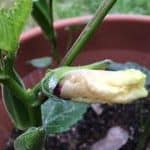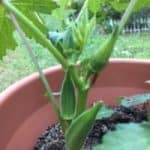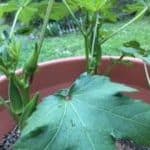
Okra
Okra is a relative of hollyhock and hibiscus. It is a plant of the tropical and warm climates that produces edible green seed pods. Its’ scientific name is Abelmoschus esculentus and also Hibiscus esculentus. In various parts of the world, it is known as Okra, Ochro, Okoro, Quimgombo, Quingumbo, Ladies Fingers, Gombo, Kopi Arab, Kacang Bendi, Bhindi (S. Asia), Bendi (Malaysia), Bamia, Bamya or Bamieh (middle east) or Gumbo (Southern USA). Gumbo means okra in Swahili.
Okra is found in its wild or natural state on the alluvial banks of the Nile. The Egyptians were the first to cultivate it in the basin of the Nile (12th century BC). It was propagated then through North Africa to the Mediterranean, the Balkans, and India. It arrived in the Americas brought by slaves at Brazil (1658), Dutch Guinea and at New Orleans before extending in the United States and going up to Philadelphia in 1781. In Louisiana, the Créoles learned from slaves the use of okra (gumbo) to thicken soups, and it is now an essential in Créole Gumbo and Southern cuisine.

In the 1800’s slaves from Africa used ground okra as a part of their diet, and this apparently led to the use of ground okra seeds as a coffee substitute by other southerners during the American Civil War blockades of the 1860’s. Ground okra is used today in West Africa to make a soup made from dried and ground okra. The seed pods were eaten cooked, and the seeds were toasted and ground, used as a coffee substitute.
Okra should be planted in warm soils of 70 degrees Fahrenheit or higher. Planting dates are mid- April to early August. Seeds will not germinate in cool soils. Seeds can be started indoors under lights in late March. Set seedlings out when soils warm. Plant seeds directly in soil a week or more after the last date of last frost. Okra is grown in full sun in well drained areas. These tall plants can block out other smaller plants.
Apply a complete fertilizer at 2-3 pounds of 8-24-24 or 3-4 pounds of 8-8-8 per 100 sq. ft. of garden. Side dress after first pod set and every four to six weeks thereafter. Seeds can be hard to sprout. Soak seeds for 5 minutes in pure chlorine bleach, rinse 3 times and plant. Sow seeds in rows of 36 inches apart then thin to 1 plant every 12 inches. Transplants work well in our area and should be planted in warm soil.
Provide 1 inch of water per week and remove weeds as they occur. Harvest pods when they are 3-inches long and still tender. Harvest every 2 days so that plants won’t become woody. Wear gloves and long sleeves to avoid contact with irritating hairs on the plants. Remove overripe pods to stimulate production. Remove any pests by hand or use pesticides minimally.
A few recommended varieties, Annie Oakley, Cajun Delight (AAS), Clemson Spineless, Cow’s Horn, Burgundy (AAS), Emerald.
submitted by Karen Blackburn




